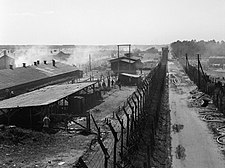
Back Bergen-Belsen-konsentrasiekamp Afrikaans معسكر بيرغن بيلسن Arabic Bergen-Belzen Azerbaijani Берген-Бельзен Byelorussian Бэрген-Бэльзэн BE-X-OLD Берген-Белзен Bulgarian Bergen-Belsen Breton Bergen-Belsen Catalan Koncentrační tábor Bergen-Belsen Czech Bergen-Belsen koncentrationslejr Danish
| Bergen-Belsen | |
|---|---|
| Nazi concentration camp | |
 View of the camp after liberation | |
| Coordinates | 52°45′28″N 9°54′28″E / 52.75778°N 9.90778°E |
| Location | Lower Saxony, Northern Germany |
| Operated by | SS-Totenkopfverbände |
| Commandant | List
|
| Original use | Prisoner-of-war camp |
| Operational | 1940–1945 |
| Inmates | Jews, Poles, Soviets, Dutch, Czechs, Germans, Austrians |
| Number of inmates | 120,000 |
| Killed | 70,000 or more |
| Liberated by | United Kingdom and Canada, April 15, 1945 |
| Notable inmates | Anne and Margot Frank |
| Website | bergen-belsen |
Bergen-Belsen (pronounced [ˈbɛʁɡn̩ˌbɛlsn̩]), or Belsen, was a Nazi concentration camp in what is today Lower Saxony in northern Germany, southwest of the town of Bergen near Celle. Originally established as a prisoner of war camp,[1] in 1943, parts of it became a concentration camp. Initially this was an "exchange camp", where Jewish hostages were held with the intention of exchanging them for German prisoners of war held overseas.[2] The camp was later expanded to hold Jews from other concentration camps.
After 1945, the name was applied to the displaced persons camp established nearby, but it is most commonly associated with the concentration camp. From 1941 to 1945, almost 20,000 Soviet prisoners of war and a further 50,000 inmates died there.[3] Overcrowding, lack of food, and poor sanitary conditions caused outbreaks of typhus, tuberculosis, typhoid fever, and dysentery; leading to the deaths of more than 35,000 people in the first few months of 1945, shortly before and after the liberation.
The camp was liberated on April 15, 1945, by the British 11th Armoured Division.[4] The soldiers discovered approximately 60,000 prisoners inside, most of them half-starved and seriously ill,[5] and another 13,000 corpses lying around the camp unburied.[4] A memorial with an exhibition hall currently stands at the site.
- ^ "Belsen Military Camp". Archived from the original on March 29, 2013. Retrieved April 3, 2012.
- ^ Shephard, Ben (2006). After daybreak: the liberation of Belsen, 1945. London: Pimlico. ISBN 978-1844135400.
- ^ Oppenheimer, Paul (1996). From Belsen to Buckingham Palace. Nottingham: Quill Press. ISBN 978-0-9536280-3-2.
- ^ a b "The 11th Armoured Division (Great Britain)". United States Holocaust Memorial Museum. Washington. Retrieved April 7, 2023.
- ^ "Bergen-Belsen". www.ushmm.org.
